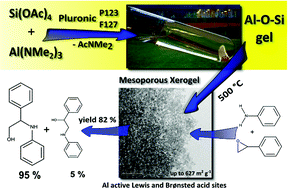Novel non-hydrolytic templated sol–gel synthesis of mesoporous aluminosilicates and their use as aminolysis catalysts†
Abstract
A novel non-hydrolytic sol–gel (NHSG) synthesis of mesoporous aluminosilicate xerogels is presented. The polycondensation between silicon acetate, Si(OAc)4, and tris(dimethylamido)alane, Al(NMe2)3, leads to homogeneous aluminosilicate xerogels containing Si–O–Al linkages through dimethylacetamide elimination. The addition of Pluronic P123 and F127 templates provides stiff gels that are, after calcination at 500 °C, converted to stable mesoporous xerogels with a high surface area (>600 m2 g−1) and wormhole-type pores (d = 5.9 nm). The xerogels exhibit high catalytic activity in aminolysis of styrene oxide (82% conversion) with the turnover frequency up to 100.



 Please wait while we load your content...
Please wait while we load your content...